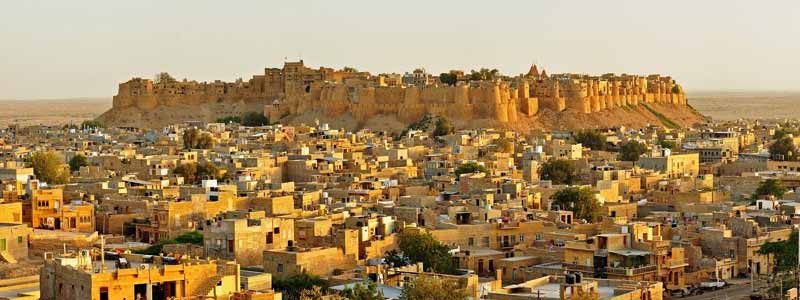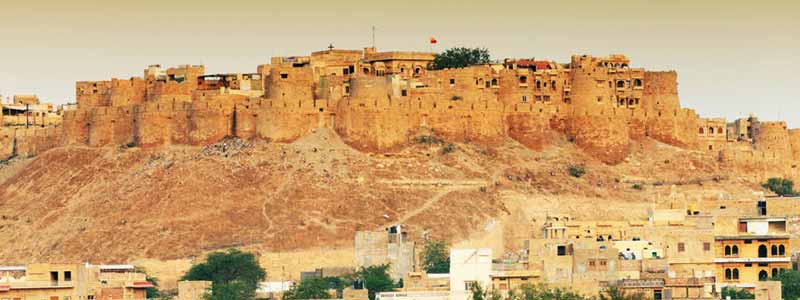Jaisalmer Fort is a monument worth visiting and worth retaining in your conscious mind. Like various other cities of Rajasthan, in Jaisalmer too you will find different facets of its own glorious heritage. Though you can find historical monuments scattered all over the city, the Jaisalmer Fort will immediately command your attention. Made of sand stones and locally known as Sonar Quila, the Jaisalmer Fort is a dominating structure amidst sands.
The city is said to be founded by one Raja Rawal Jaisal, a Bhatti Rajput ruler, in approximately 1156 A D. Legends go by that he did it on the behest of a local hermit named Eesaal. The raja choose Trikuta hill as the new site for his fort as his earlier adobe at Luderwa(16 k.m from present Jaisalmer Tour Packages) was too vulnerable to his comfort. But it should always be kept in mind that these legends are most of the time product of conscious minds that are very vulnerable to the oriental exaggeration.
Jaisalmer fort is the second oldest in Rajasthan. Two hundred and fifty feet tall and reinforced by imposing crenellated sandstone wall 30 feet high; it has 99 bastions, 92 of which were built between 1633 and 1647. Wells within the fort still provide a regular source of water. Even today, you will find that nearly one fourth of the old city’s population resides within the fort. If you are a student of cross-cultural merging, the subtle fusion of Rajput and Islamic architectural styles, visible in this fort, will catch your fancy. Ganesh Pol, Akshya Pol, Suraj Pol and Hawa Pol are a must see.

Interesting Facts about Jaisalmer Fort:
- There are many attractions including Raj Palace, Jain temples, Laxminath Temple and the four gateways – Ganesh Pol, Suraj Pol, Bhoot Pol and the Hawa Pol located within the fort
- Jaisalmer Fort is located in the Thar Desert, which is the world’s ninth largest tropical desert
- Jaisalmer Fort is one of the largest fortifications in the world and is made up of three layers
- There are two important public places called the Gopa Chowk and Dussera Chowk, which attracts tourists, musicians, and shopkeepers
- The narrow lanes inside the Jaisalmer Fort are worth exploring and they lead to various parts of the fort

History of Jaisalmer Fort
The Golden fort is said to be established by Raja Rawal Jaisal, who was a Bhatti Rajput ruler, in approximately 1156 A D. He selected the Trikuta hills located at the great Thar Desert for his fort to stand and symbolize the dominance and power of the royal Rajput’s.
Sonar Quila is known as the second oldest fort in Rajasthan and has seen and been part of many legendary battles but even today it holds the same charm and positive vibes which will leave you aw-struck when you will witness this great structure. So, one can notice the fusion of Islamic and Rajput architecture. It has also been part of the silk trade route from the 16th to the 18th century.
Sonar Quila is a legendary structure and holds a great significance in the grand history. Jaisalmer Tourism The fort has four grand entrance Ganesh Pol, Akshaya Pol, Suraj Pol, and Hawa Pol which have their own significance like Suraj pol named was given to one because the first sun rays over the city used to hit this very gate similarly other gates also have interesting stories related to them and are very beautifully carved and designed in a way that it is a combination of power and beauty.
The Architecture of Jaisalmer Fort
The Jaisalmer Fort is also famous for its architectural beauty. With the amazing measurement of 1,500 ft (460 m) long and 750 ft (230 m) wide it is built on a hill that rises above a height of 250 ft (76 m). You will be delighted to witness the essence of Rajasthani architectural touch with beautiful designs and patterns. Built with the gorgeous yellow sandstone the entire fort has an amazing look and shines like gold when the sun-rays fall on the walls.
With the glorious sunrise and majestic sunset, this structure changes color from tawny lion yellow to honey- gold. You will be amused to see the four entrances to the fort which are named Hawa Pole, Akshay Pole, Suraj Pole, and Ganesha Pole. There are many other places that add their importance to histories such as Akhai Vilas, the Rang Mahal, Sarvottam Vilas, Gaj Mahal, and the Moti Mahal Jaisalmer Monuments.
The Moti Mahal is also known as Salam Singh Ki Haweli and is extremely beautiful with the amazing architecture, built-in 1815 with a peacock-shaped roof & numerous balconies this place will give a jaw-dropping view. These places too have been formed by keeping the designs, patterns, and texture at the priority and has been taken utmost care that they stand to showcase the royalty and energy of Rajput’s and taking Rajasthani style on another level.
Best time to visit the Jaisalmer Fort:
The best time to visit the Jaisalmer Fort is from November to March. It is the best time to enjoy sightseeing, camel ride, desert safari and exploring Jaisalmer.
Timings and Entry Fees:
The timings to visit Jaisalmer Fort is 6 AM – 5 PM. The entry fees for Indians is 50 INR and 250 INR for foreigners.
How To Reach
By Air: As Jaisalmer does not have any airport within the city so, the nearest airport to this place is Jodhpur airport which is connected with domestic and international flights to and from major places and is around 275 kilometers from Jaisalmer.
By Train: You can also choose to visit with the help of the train as Jaisalmer has good connectivity from the trains to major cities like Delhi, Jaipur, Mumbai, etc.
By Road: Jaisalmer is well connected to the major cities via roadways also so you can choose any public transport like buses or private transport like cars etc. to reach the Jaisalmer fort.
